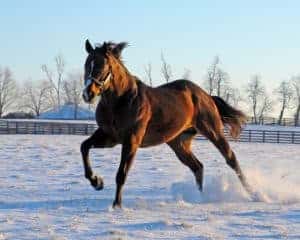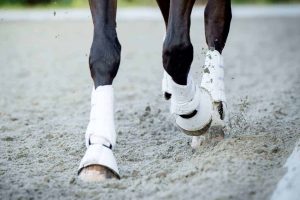The Top 5 Signs and Factors Flagging an Ulcery Horse

Would you recognize if your horse had ulcers in his stomach?
Doing so isn’t always easy—especially because horses often don’t show obvious signs of ulcers, even though they can be quite painful, said Sara Busechian, DVM, PhD, MRCVS, at the Department of Veterinary Medicine in the University of Perugia, in Italy.
But gastric ulcers are—unfortunately—common, with approximately 90% of competitive sport horses having them at some point in their careers and with new estimates showing around 60% of leisure horses have them as well, Busechian said. Even donkeys can develop them, she added.
That’s mainly due to how the equine digestive system works. “Horses are physiologically predisposed, because they produce gastric acid continuously throughout the day, whereas human beings only produce gastric acid when they eat,” she said. “So obviously, the main thing is letting them eat about 20 hours a day. But apparently even that’s not enough, because even pastured horses get ulcers.”
Ulcers can happen in two parts of the stomach: the upper part with the smooth, squamous cell lining that’s a lot like an esophagus, and the lower part that’s covered in bumpy glands, much like the human stomach. Ulcers in one part of the stomach don’t necessarily develop for the same reasons as in the other part, and they won’t always cause the same clinical signs.
Despite these differences, though, some basic clues can point to an ulcery horse regardless of the ulcer type. By watching for these top five factors and signs, you can get critical hints about when it might be time to have your veterinarian scope your horse.
Signs Your Horse Might Have Gastric Ulcers
- Avoiding grain. Starchy feed triggers more acid release, so grain can upset an ulcery stomach, said Benjamin Buchanan, DVM, Dipl. ACVIM, ACVECC, of Brazos Valley Equine Hospital, in Navasota, Texas. “If there isn’t enough fiber in their stomach to buffer the acid, they’ll learn that they can stop and go eat their hay for a bit, and then come back and finish the grain or just leave the grain altogether because it’s irritating,” he said.
- Weird behavior, especially at feeding time: Ulcers could be particularly painful when horses eat or drink on an empty stomach, as the food or water hits the exposed lesions. So that might be why horses refuse to eat, or eat and stop, or turn their heads around to their bellies. “They’ll repeatedly reach behind their elbow, and nuzzle their abdomen, in the middle area (from top to bottom), a few inches behind their shoulder, and they’ll do that repeatedly on both sides,” said Sue McDonnell, PhD, CAAB (Certified Applied Animal Behaviorist) an equine behavior specialist at the University of Pennsylvania’s New Bolton Center, in Kennett Square. They might even have wet or ruffled haircoat on their sides from nuzzling or gnawing at those spots, she added. Horses with GI discomfort may also shift weight frequently on their hind limbs, swish or smack their tails, or orient their ears back. Lying down and getting up may also trigger them to show signs of discomfort—easily recognizable using her team’s downloadable discomfort ethogram—and to gaze back toward their abdomen “probably because the gastric acidic juices are sloshing around,” she said. Some horses increase how often they stretch down with their forelimbs reaching downward (in a “downward dog” stretch) and their back lowered and concave to stretch out the belly muscles—although such stretching could indicate other kinds of abdominal pain as well. Even so, the increase might be so subtle you’d have to videotape your horse 24 hours a day and view it in fast forward to appreciate the frequency and repetitiveness of the cluster of related GI discomfort behaviors, she explained.
- Inconsistent grumpiness. Horses could be grumpy and aggressive or they could act normal—it depends on whether the stomach is currently feeling irritated, said Buchanan. They could show unpleasant behavior, such as threatening to bite, kick, or buck, with their riders under saddle, handlers on the ground, or even other horses. They might also pin their ears during saddling. “It’s not a consistent behavior, though, because sometimes their stomach is full of fiber, so it doesn’t hurt,” he said.
- Reduced performance. Is your horse not working as well as he used to? Is he resistant or sluggish? Maybe he’s also looking a little thin and dull. These are all signs pointing to ulcers, Buchanan explained. “When you’ve got performance problems that you can’t block out to any specific sports medicine injury, looking at the stomach is high on the list of things to do,” he said.
- A high-stress life (even short-term). Heavy exercise, transportation, living in a stall, getting separated from their buddies—these are all high sources of stress that could trigger ulcers, said Busechian. “Anything stressful for the horse can potentially lead to gastric ulcers, including any change—even a small one—from changing companionship to changing their environment.” Those kinds of changes aren’t limited to sport horses, she added. “This could happen to basically any horse, especially ones that live in the field with companions, so those horses shouldn’t be overlooked,” she said.
If you recognize any of these signs or risk factors, consider discussing your concerns with your veterinarian, our sources said. A gastroscopy—the only way to truly diagnose equine gastric ulcer syndrome (EGUS), according to Buchanan—might be in order.

Related Articles
Stay on top of the most recent Horse Health news with

















